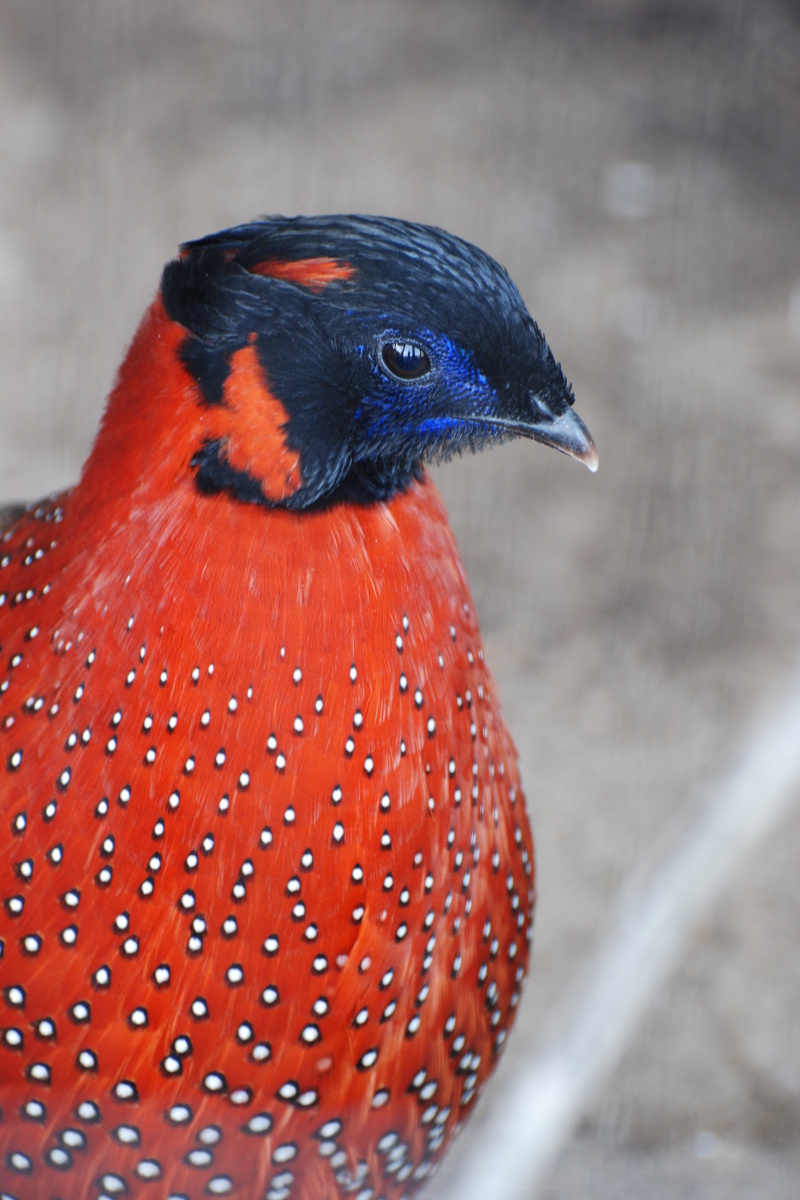- Phasianidae
image_width = 200px
image_caption =Satyr Tragopan
regnum =Animal ia
phylum = Chordata
classis = Aves
ordo =Galliformes
familia = Phasianidae
familia_authority = Horsfield, 1821
subdivision_ranks = Genera
subdivision = Many, see textThe Phasianidae is a family ofbird s which consists of thepheasant s andpartridge s, and including the junglefowl, Old World quail, francolins, monals and peafowl. The family is a large one, containing 38 genera and around 138 species. The family is occasionally broken up into two subfamilies, the Phasianinae, which holds 49 species of pheasant, and the Perdicinae, which holds the 106 remaining species. Sometimes additional families and birds are treated as being in this family as well; theAmerican Ornithologists' Union includes Tetraonidae, Numididae, and Meleagrididae in Phasianidae as subfamilies.Distribution
The pheasants and their allies are an Old World family, with a distribution that includes most of Europe and Asia (except the far north), all of
Africa except the driest deserts and down into much of easternAustralia and (formerly)New Zealand . The greatest diversity of species in in Southeast Asia and Africa. Amongst the pheasants, with the exception of theCongo Peafowl , the distribution is entirely restricted to Asia; the Perdicinae have a much more widespread distribution. Within their range they occupy almost every available habitat except for boreal forest and tundra.The family is generally sedentary and resident, although some quails undertake long migrations. Several species in the family have been widely introduced around the world, particularly pheasants which have been introduced to Europe, Australia and the Americas. Captive populations of peacocks and chickens have also escaped and become
feral .Description
Phasianids are terrestrial, ground living species. They are variable in size and ranging from 43 g, in the case of the
Asian Blue Quail , to 6 kg in the case of theIndian Peafowl . There is generallysexual dimorphism in size, with males tending to be larger than females. They are generally plump, with broad relatively shortwing s and strong legs. Many have aspur on theirleg s, a feature shared with guineafowl and turkeys but no other galliform birds. The bill is short and generally strong, particularly in species that dig in order to obtain food. Males of the largerspecies often have brightly colouredplumage as well as facial ornamentations such as wattles or crests.Behaviour
The pheasants and partridges have a varied diet, with foods taken ranging from purely vegetarian diets of seeds, leaves, fruits, tubers and roots, to small animals including insects, insect grubs and even small reptiles. Most species either specialise in feeding on plant matter or are predatory, although the chicks of most species are insectivorous.
In addition to the variation in diet there is a considerable amount of variation in breeding strategies amongst the Phasianidae. Compared to birds in general there is a large number of species that do not engage in
monogamy (the typical breeding system of most birds). The francolins of Africa and some partridges are reportedly monogamous, but polygamy has been reported in the pheasants and junglefowl, some quail, and the breeding displays of peacocks have been compared to those of alek . Nesting usually occurs on the ground; only thetragopan s nest higher up in stumps of bushes. Nests can vary from monds of vegetation to slight scrapes in the ground. As many as 18 eggs can be laid in the nest, although 7-12 is the more usual number, with smaller numbers in tropical species. Incubation is almost always performed by the female only, and last from 14-30 days depending on the species.Relationship with humans
Several species of pheasant and partridge are extremely important to humans. The
Red Junglefowl of Southeast Asia is the wild ancestor of the domesticatedchicken , the most important bird in agriculture.Ring-necked Pheasant s, several partridge and quail species and some francolins have been widely introduced and managed as game birds for hunting. Several species arethreatened by human activities.Genera
*
Quail s:
** "Coturnix " (9 species)
*** "Anurophasis monorthonyx" (Snow Mountain Quail )
** "Perdicula " (4 species)
*** "Ophrysia superciliosa" (Himalayan Quail )
*Partridge s
** "Alectoris " (7 species)
** "Ammoperdix " (2 species)
** "Arborophila " (Hill Partridges, 18 species)
** "Bambusicola " (Bamboo Partridges , 2 species)
** "Caloperdix" (Ferruginous Partridge , 1 species)
** "Haematortyx" (Crimson-headed Partridge , 1 species)
** "Lerwa" (Snow Partridge , 1 species)
** "Margaroperdix" (Madagascar Partridge , 1 species)
** "Melanoperdix" (Black Wood-partridge , 1 species)
** "Perdix " (3 species)
** "Ptilopachus" (Stone Partridge , 1 species)
** "Rhizothera" (Long-billed Partridge , 1 species)
** "Rollulus" (Crested Wood Partridge , 1 species)
** "Xenoperdix " (2 species)
*Pheasant s:
** "Argusianus " (2 species)
** "Catreus" (Cheer Pheasant , 1 species)
** "Chrysolophus " (2 species)
** "Crossoptilon " (Eared Pheasant s, 4 species)
** "Ithaginis" (Blood Pheasant , 1 species)
** "Lophura " (10 species)
** "Phasianus " (2 species)
** "Polyplectron " (Peacock Pheasant s, 7 species)
** "Pucrasia" (Koklass Pheasant , 1 species)
** "Rheinartia" (Crested Argus Pheasant , 1 species)
** "Syrmaticus " (5 species)
*Snowcock s
** "Tetraogallus" (5 species)
*Francolin s
** "Francolinus" (41 species)
*Spurfowl s
** "Galloperdix" (3 species)
*Tragopan s
** "Tragopan" (5 species)
*Monal s
** "Lophophorus" (3 species)
*Peafowl (may be part of a distinct family)
** "Pavo" (2 species)
** "Afropavo" (Congo Peafowl , 1 species)
*Junglefowl
** "Gallus" (5 species, including the domesticchicken )References
* McGowan, P.J.K. (1994) Family Phasianidae (Pheasants and Partridges) P.p. 434-479 "in" del Hoyo, J.; Elliot, A. & Sargatal, J. (editors). (1994). "
Handbook of the Birds of the World . Volume 2: New World Vultures to Guineafowl". Lynx Edicions. ISBN 8487334156External links
* [http://www.hbw.com/ibc/phtml/familia.phtml?idFamilia=38 Phasianidae videos] on the Internet Bird Collection
*dmoz|Science/Biology/Flora_and_Fauna/Animalia/Chordata/Aves/Galliformes/Phasianidae/|Phasianidae
Wikimedia Foundation. 2010.

